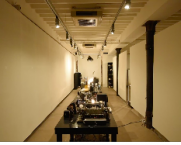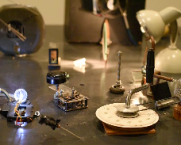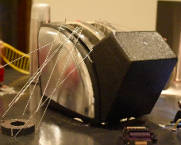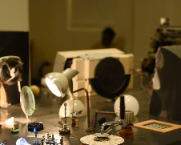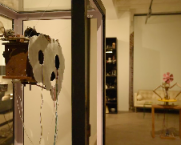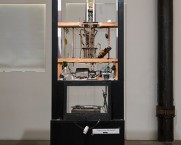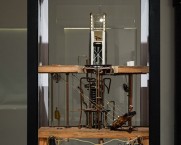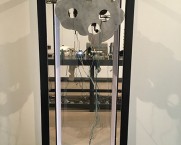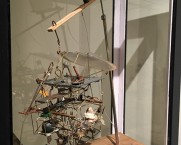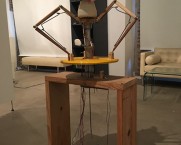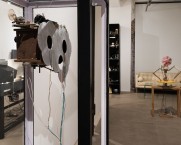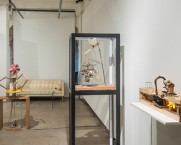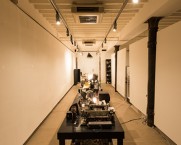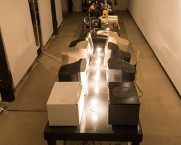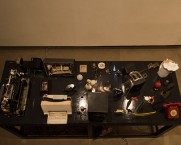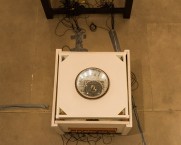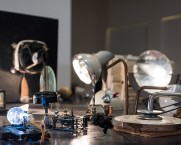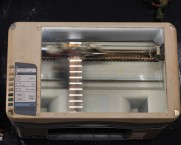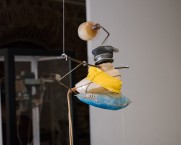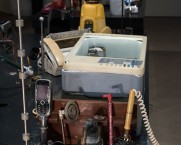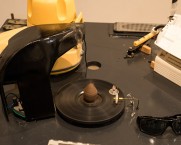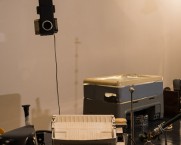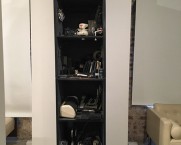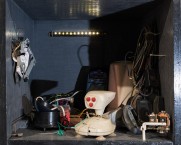C&L Shows
Squeeze Lime In Your Eye
Kausik Mukhopadhyay
2017

Overview
The Animism of the Machine:
Kausik Mukhopadhyay’s Autobiography in Moving Parts
~Ranjit Hoskote
“The second part of his apparatus was a square wire hanger. That was the receiver. If he was right, invisible waves would fly out from his transmitter, travel across the auditorium, and reach this metal hanger. To confirm that they had arrived, he had cut a tiny gap in the hanger. If an invisible wave arrived, it would have to cross that gap and would produce yet another spark.”
~ David Bodanis, Electric Universe [1]
‘Squeeze Lime in Your Eye’ marks Kausik Mukhopadhyay’s triumphant return to the Indian art scene after many years spent in research, experiment and teaching at one of Bombay’s most energetic architecture schools. Like the protagonist of Ritwik Ghatak’s cinematic masterpiece, Ajantrik, Mukhopadhyay is happiest when he is talking to machines. His workspace is more laboratory or factory floor than studio, replete with motor components, IC chips, fretsaws, adzes, drills, drill bits, blowtorches, screwdrivers and cables of every conceivable size and specification (growing up as the son of an engineer, the artist embraced tools and the mechanical arts as part of his early socialisation). Improvising in the borderland between sculpture and mechanical object, he assembles and reconfigures the most fundamental machine elements – gears, levers, pulleys, motors – into complex, precarious choreographies.
Mukhopadhyay incarnates the archetype of the artist as inventor; his art-making is based on a voracious collecting practice. His primary material, as he puts it, is “discarded household gadgets”, the disjecta membra of a postcolonial economy that has made the transition from thrift to throwaway in a matter of decades. His assemblages are composed from parts found, crafted, repaired, repurposed from the tidal flows of white and brown goods on which we sail: toasters, kettles, ovens, printers, scanners, headphones, SLR cameras, computer keyboards, monitors, vacuum cleaners, and the occasional squat rotary-dial telephone that was once a standard feature of metropolitan Indian homes. Entire life cycles of manufacture, exchange and recycling are exposed to view through Mukhopadhyay’s orchestrations.
‘Composed’ may not be the right word. Riffing on the scientific working model and the booby trap as they do, these fantastic, seemingly whimsical ensembles refuse to sit still. Once the artist and his acolytes have propitiated the deities who preside over the wiring, and the synapses have fired across the contacts, rotors whirl, printer carriages shuttle and chatter across take-up reels, alarms go off hooting and screeching. Calibrations of speed, an interplay of the regular and the erratic, a counterpoint between anticipation and unpredictability are integral to the performance: for these kinetic sculptures play their role in an eccentric ballet or marionette dance of mechanical and cybernetic objects. Depending on how the circuits are organised, these works can lie still until the viewer has been lulled into trustfulness, then burst, all-systems-go, into a festive, percussive momentum verging on frenzy. Exposing the innards of the machinery at his disposal, rendering these everyday objects startlingly unfamiliar, Mukhopadhyay celebrates the latent, too-naturalised magic of the mechanical: invisible waves and fields, signals passing through the ether, forces at a distance. He is the von Karajan of a high-spirited cacophony orchestra.
*
Adopting a DIY aesthetic as he does, Mukhopadhyay turns his back on the kind of high finish that has been de rigueur in much postcolonial Indian art. However, the rough edges are deceptive; his bricolage embodies a sophisticated relay among multiple historical horizons. Let us begin with his densely populated installation, ‘Small, Medium, but not Large’, which extends across three long tables, with ancillary apparatus connected to the main frame of its machinery. There are lamps here and an optician’s equipment, as well as knobs, levers, crank handles, and a plethora of devices that have finished with their years of active service to society and entered a post-mechanical afterlife that offers us a choice of trick or treat, prank or epiphany. Except that we can’t always tell which is which.
At first glance, ‘Small, Medium, but not Large’ exhibits a vivid affinity with the oeuvre of the Swiss artist duo, Peter Fischli and David Weiss. Mukhopadhyay shares, with Fischli/ Weiss, a preoccupation with the encyclopaedic collection of ephemera, and with crazy perpetual motion machines; the latter preoccupation is displayed to advantage in such works as the Swiss duo’s 1987 film, ‘Der Lauf Der Dinge’ (‘The Way Things Go’). Unlike the event sequences that Fischli/ Weiss staged and documented, however, Mukhopadhyay’s works are far more non-linear, operating through blurred causalities, irregular mechanisms of delay and release, and randomized outcomes generated by the aleatory programming of a makeshift architecture.
The more time the viewer spends with ‘Small, Medium, but not Large’, the more s/he realizes that these tables are Sisyphean forms of inventory, informed in equal measure by drollery and anxiety. They are sites where the multiplication of objects translates into a proliferation of sensory experiences. In these staging areas, the patient labour of compilation, premised on containment, will always be defeated by the eccentric pleasure of collecting, predicated on excess. In effect, they are jokes at the expense of the archive. The senses are locked firmly in the crosshairs here: Mukhopadhyay’s machinery subjects us to auditory surprises, shocks and disappointments; invites us to use a variety of optical devices to expand, distort or disorient sight; encourages us to initiate actions that seem futile but result in sudden effects, or conversely, that seem purposeful yet achieve little or nothing. ‘Small, Medium, but not Large’ is an elaborate ambush.
And yet, even as it seems designed to ambush us, which argues a degree of coolness and deliberation, I suspect that this work is also the expression of a febrile, all-consuming anxiety – an anxiety concerning the cognitive coherence and physical integrity of a human subject at risk from fissiparous impulses both external and internal, uncertain of its location and ability to participate in a world of intersubjective relationships relentlessly mediated through technological processes and artifacts. Seen in this light, the scattered fragments on Mukhopadhyay’s tables, which claim the attention of sight, hearing, touch, smell and taste, could be regarded as the dismembered parts of an Osirian body, calling out to be made whole again. Like all comedy, ‘Small, Medium, but not Large’ is veined with an abiding sense of the tragic.
*
Mukhopadhyay’s emphasis on kinetic sculpture situates him in a genealogy that can be traced back to such seminal figures as Francis Picabia and Jean Tinguely. Walking through ‘Squeeze Lime in Your Eye’, doubling back in response to a half-glimpsed visual summons, alert to a shift of tone or an unprecedented sonic challenge, I am strongly reminded of Picabia’s ‘Mechanomorphs’, drawings of animated machines whose surreal, erotically charged physiognomy revealed them to be oblique, satirical portraits of humankind in the epoch of industry, capital and consumption. I am reminded forcefully, also, of Jean Tinguely’s phantasmagorical cybernetic ensembles, many of them constructed from discarded materials and orchestrated into a restless choreography, and some of which, such as the ‘Métamatics’ series, were programmed to perform and often self-destruct.
That said, I would speculate that Mukhopadhyay’s fascination with the enchantment and terror of the machine could also be continuous with that robust tradition of Bengali science and fantasy fiction, of which Premendra Mitra and Satyajit Ray were stellar practitioners. Like Mitra’s Ghana-da and Ray’s Professor Shonku, Mukhopadhyay’s artist-persona combines elements of the curious investigator, the fantasist, and the restless pioneer of uncharted horizons. [2]
“If he was right…” Sparked off by chance, a hunch, a wager, scientific explorations often proceed no differently from magic, divination and prestidigitation, as shown by the epigraph to the present essay, David Bodanis’ account of an experiment by the German physicist Heinrich Hertz to demonstrate the existence of electromagnetic waves. Born 1960, Mukhopadhyay was only seven when the far-Leftist Naxalite uprising began to sweep through West Bengal. He spent his childhood and adolescence in the politically turbulent yet culturally vibrant Calcutta of the 1960s and 1970s, reading Science Today (it was also the heyday of India’s science popularisation movement), playing with Meccano sets and mechanical clocks, crafting model boats and planes with balsa kits and miniature motors. Those of us who grew up in India in the second half of the 20th century will recognise, in the hinterland of Mukhopadhyay’s visual emphases, the imagery of the Nehruvian state’s romance with industrialisation: the cut-away section views of factories, the iconic representations of turbines, hydraulic machinery, tractors and cranes, the gleaming factory assembly-lines and heroic smokestacks, and all the other invocations to the industrial Sublime familiar from the photography of Sunil Janah and Mitter Bedi. The register of the paean is disrupted, of course, by that of the dithyramb in Mukhopadhyay’s handling.
During the mid-1980s, as a student at the Rabindra Bharati University, Calcutta – where he studied before going to Santiniketan – Mukhopadhyay became a member of the Students Federation of India, founded in 1970 as a youth wing of the Communist Party of India (Marxist). During this period, he worked with fellow artists who were involved with theatre. The reigning spirit of the stage in Calcutta, at this time, was the experimental master Badal Sircar, who had moved out of designated cultural spaces and into ‘found’ spaces in streets and neighbourhood meeting-places. Having rejected bourgeois proscenium theatre, with its elaborate sets and lighting, Sircar improvised with discontinuity, shadow psychologies, the crackling energy of events, the rough-and-tumble of circumstance. The Soviet Union, now long vanished, was an important source of cultural inspiration to many young Indians during these decades; one of Mukhopadhyay’s recent works, which features an old vinyl record produced by the USSR’s official record label Melodiya, triggers off memories of that vanished epoch.
It is in the primary armature of these early experiences, in a home that was splendidly open to the world, that I would situate the artist’s practices. I would suggest that his choices were not shaped so much as they were reinforced by his reading of Dadaism in Calcutta and Santiniketan, and his exposure to the ideas and strategies of the Fluxus group, with which he became acquainted during his residency as a fellow at the Kanoria Centre for Arts, Ahmedabad, in the early 1990s. That said, Ahmedabad was undoubtedly a fertile moment in his trajectory as a cultural producer, a time of intense dialogues with his contemporaries at CEPT (Centre for Environmental Planning and Technology) and the NID (National Institute of Design), which would influence his decision to set up base, as a teacher, at an architecture school rather than an art school.
*
Home is an insistent leitmotif in Mukhopadhyay’s recent works, as their titles attest: ‘The Cloud Home’, ‘The Music-lover’s Home’, ‘Father’s Home’, ‘Mother’s Home’, ‘Green Home’. To my polyglot consciousness, these works sing of their umbilical connection with Bengali cinema, its alternately joyous and melancholy evocation of the baadi, the elusive home and by extension homeland, shaken by the Partition of 1905, lost to the Partition of 1947, carried in memory to the refugee colonies of Calcutta, regarded with wonder from across a riverine border. Ghoti or Bangal, resident, probashi or friend of the region, no one who is associated with Bengali culture is immune to its call. In their unpredictability, precariousness and their irrepressible wondrousness, Mukhopadhyay’s kinetic sculptures encrypt the inescapeable presence of historical trauma and articulate the artistic will to bear witness and overcome.
We are reminded here, strongly, of the domestic interior and the space of the family as a fraught, crackling diagram of power relationships but also as the theatre of dreams and aspirations. Ghatak’s Meghe Dhaka Tara and Subarnarekha – the cry of the woman, diagnosed with a terminal illness, who wishes to live; the eyes of the child who hopes he will be taken to his new home, his nutan baadi – inhabit these works, as does Ray’s Jalsaghar, centred on the patron who desires to summon up lost grandeur and the richness of music one last time, before he is overtaken by bankruptcy and collapse.
‘Squeeze Lime in Your Eye’ is, I would suggest, readable as a scrambled, adroitly coded memoir, an autobiography in moving parts – of a person, a period, and an artistic stance. Kausik Mukhopadhyay imbues his broken, dismantled and recombined ensembles with soul and voice. Through this animism of the machine, he reminds us of the residues of labour, passion, hope and reverie that we may have lost to the disembodied seductions of the digital age, the forms of delegation and interpassivity disguised as interactivity that it makes all too persuasively available. [3] This is a lesson both to the art world in particular, and to the world at large.
(Bombay, January-March 2017)
Notes
- David Bodanis, Electric Universe: How Electricity Switched On the Modern World (New York: Three Rivers Press, 2005), p. 98.
- For an account of Bengali science fiction, see Debjani Sengupta’s excellent essay, ‘Sadhanbabu’s Friends: Science Fiction in Bengal from 1882-1961’, in Jeebesh Bagchi, Monica Narula, Geert Lovink et al eds., Sarai Reader 03 | Shaping Technologies (New Delhi: CSDS/ Sarai & Amsterdam: Waag, 2003), pp. 76-82. See link (accessed 20 January 2017):
http://archive.sarai.net/files/original/e067355930e46f0f188b0fc0e5348cc5.pdf
- Interpassivity is a term invented by the Austrian philosopher and cultural theorist Robert Pfaller in 1996 to designate the increasing tendency, in an epoch of accelerated cultural consumption and the ubiquity of mediatic and communications technology, to delegate one’s experiences to one’s cybernetic prostheses, interfaces or filters, to be recorded, disseminated or (re)viewed at leisure. Contemporary examples would include the selfie craze, the addiction to Facebook and Instagram updates, and the well-documented phenomenon of museum viewers standing before a historic work of art and consulting its internet reflections on their smartphones or iPads instead of trusting the evidence of their senses and being in the present moment. I first became aware of interpassivity in the course of a meeting and subsequent conversations with Pfaller at Kloster Pernegg, Austria, May 1998. For an extended account, see Pfaller, Interpassivity: The Aesthetics of Delegated Enjoyment (Edinburgh: Edinburgh University Press, 2017).
- Video Documentation
- Installation Images
Video Documentation

